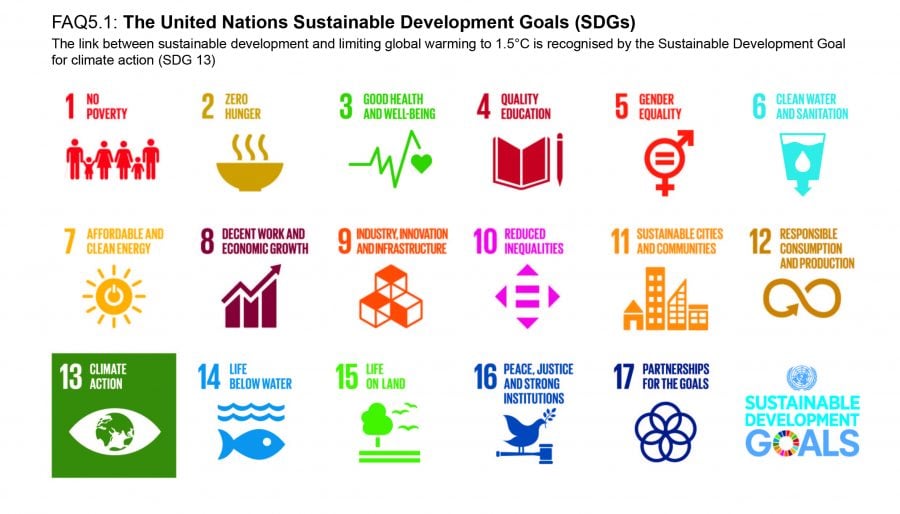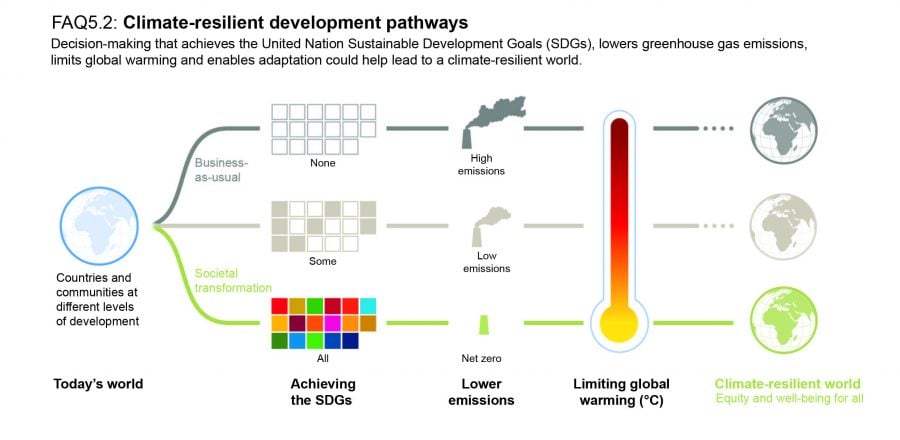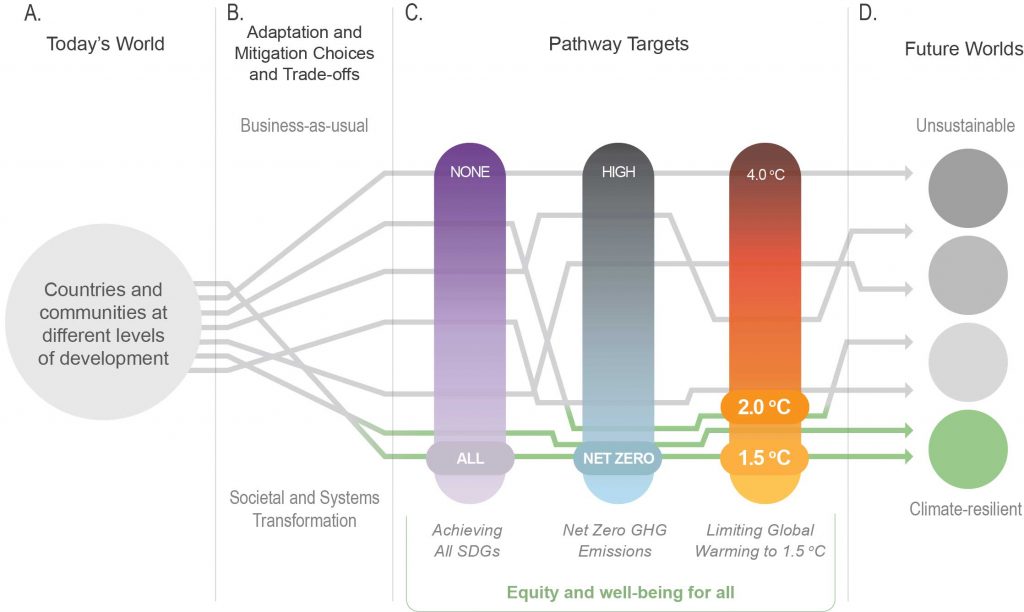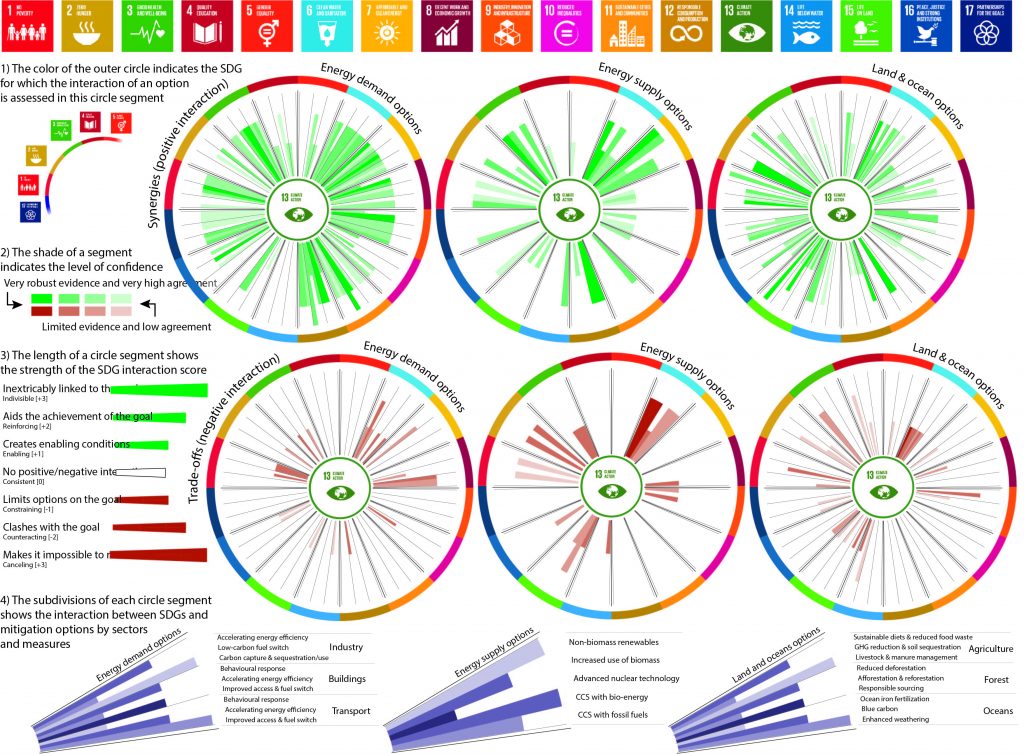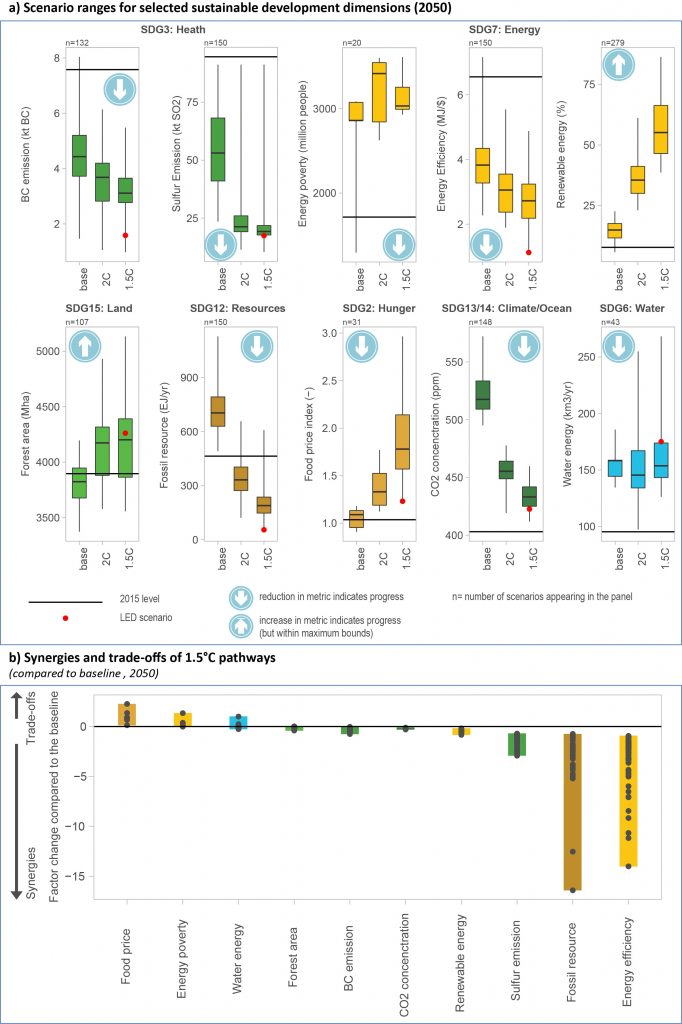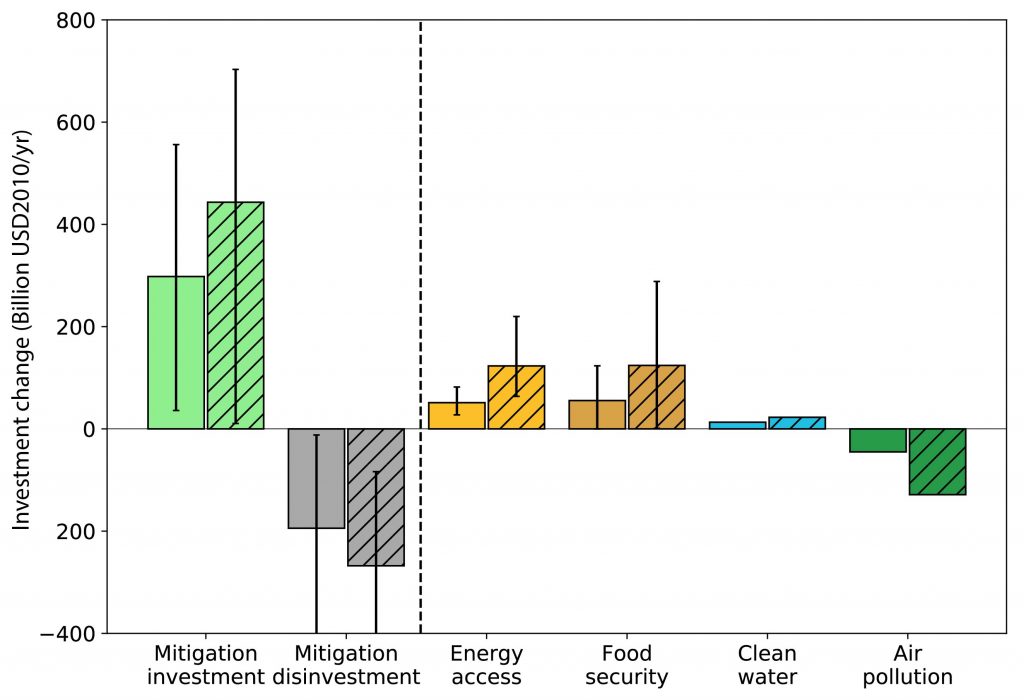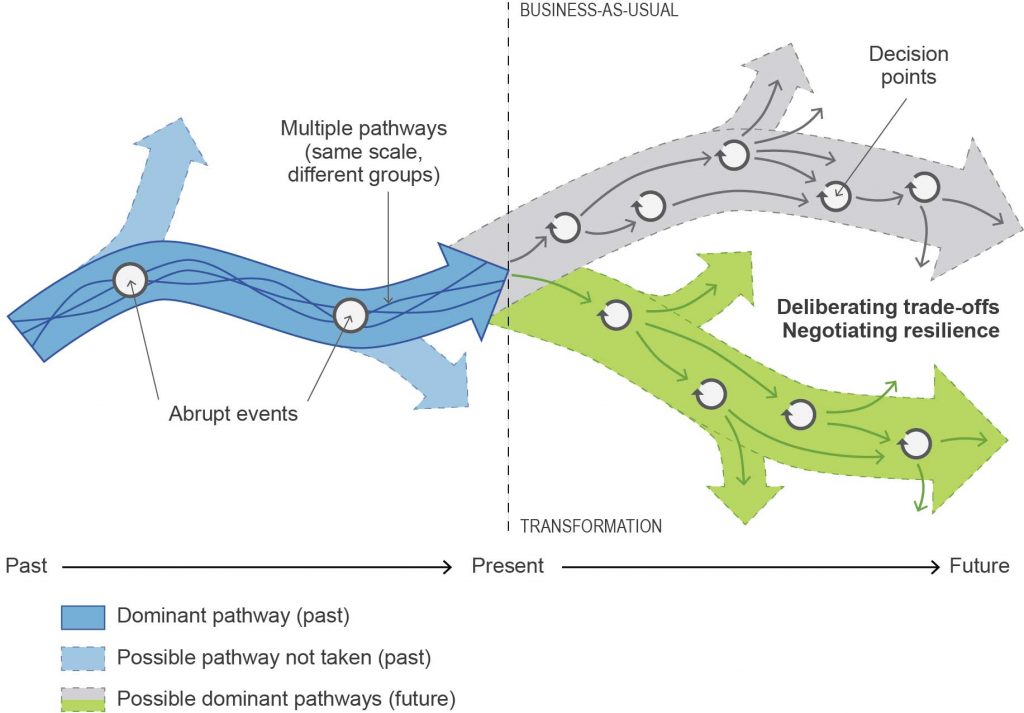ES
Executive Summary
This chapter takes sustainable development as the starting point and focus for analysis. It considers the broad and multifaceted bi-directional interplay between sustainable development, including its focus on eradicating poverty and reducing inequality in their multidimensional aspects, and climate actions in a 1.5°C warmer world. These fundamental connections are embedded in the Sustainable Development Goals (SDGs). The chapter also examines synergies and trade-offs of adaptation and mitigation options with sustainable development and the SDGs and offers insights into possible pathways, especially climate-resilient development pathways towards a 1.5°C warmer world.
Sustainable Development, Poverty and Inequality in a 1.5°C Warmer World
Limiting global warming to 1.5°C rather than 2°C above pre- industrial levels would make it markedly easier to achieve many aspects of sustainable development, with greater potential to eradicate poverty and reduce inequalities (medium evidence, high agreement). Impacts avoided with the lower temperature limit could reduce the number of people exposed to climate risks and vulnerable to poverty by 62 to 457 million, and lessen the risks of poor people to experience food and water insecurity, adverse health impacts, and economic losses, particularly in regions that already face development challenges (medium evidence, medium agreement). {5.2.2, 5.2.3} Avoided impacts expected to occur between 1.5°C and 2°C warming would also make it easier to achieve certain SDGs, such as those that relate to poverty, hunger, health, water and sanitation, cities and ecosystems (SDGs 1, 2, 3, 6, 11, 14 and 15) (medium evidence, high agreement). {5.2.3, Table 5.2 available at the end of the chapter}
Compared to current conditions, 1.5°C of global warming would nonetheless pose heightened risks to eradicating poverty, reducing inequalities and ensuring human and ecosystem well- being (medium evidence, high agreement). Warming of 1.5°C is not considered ‘safe’ for most nations, communities, ecosystems and sectors and poses significant risks to natural and human systems as compared to the current warming of 1°C (high confidence). {Cross- Chapter Box 12 in Chapter 5} The impacts of 1.5°C of warming would disproportionately affect disadvantaged and vulnerable populations through food insecurity, higher food prices, income losses, lost livelihood opportunities, adverse health impacts and population displacements (medium evidence, high agreement). {5.2.1} Some of the worst impacts on sustainable development are expected to be felt among agricultural and coastal dependent livelihoods, indigenous people, children and the elderly, poor labourers, poor urban dwellers in African cities, and people and ecosystems in the Arctic and Small Island Developing States (SIDS) (medium evidence, high agreement). {5.2.1, Box 5.3, Chapter 3, Box 3.5, Cross-Chapter Box 9 in Chapter 4}
Climate Adaptation and Sustainable Development
Prioritization of sustainable development and meeting the SDGs is consistent with efforts to adapt to climate change (high confidence). Many strategies for sustainable development enable transformational adaptation for a 1.5°C warmer world, provided attention is paid to reducing poverty in all its forms and to promoting equity and participation in decision-making (medium evidence, high agreement). As such, sustainable development has the potential to significantly reduce systemic vulnerability, enhance adaptive capacity, and promote livelihood security for poor and disadvantaged populations (high confidence). {5.3.1}
Synergies between adaptation strategies and the SDGs are expected to hold true in a 1.5°C warmer world, across sectors and contexts (medium evidence, medium agreement). Synergies between adaptation and sustainable development are significant for agriculture and health, advancing SDGs 1 (extreme poverty), 2 (hunger), 3 (healthy lives and well-being) and 6 (clean water) (robust evidence, medium agreement). {5.3.2} Ecosystem- and community- based adaptation, along with the incorporation of indigenous and local knowledge, advances synergies with SDGs 5 (gender equality), 10 (reducing inequalities) and 16 (inclusive societies), as exemplified in drylands and the Arctic (high evidence, medium agreement). {5.3.2, Box 5.1, Cross-Chapter Box 10 in Chapter 4}
Adaptation strategies can result in trade-offs with and among the SDGs (medium evidence, high agreement). Strategies that advance one SDG may create negative consequences for other SDGs, for instance SDGs 3 (health) versus 7 (energy consumption) and agricultural adaptation and SDG 2 (food security) versus SDGs 3 (health), 5 (gender equality), 6 (clean water), 10 (reducing inequalities), 14 (life below water) and 15 (life on the land) (medium evidence, medium agreement). {5.3.2}
Pursuing place-specific adaptation pathways towards a 1.5°C warmer world has the potential for significant positive outcomes for well-being in countries at all levels of development (medium evidence, high agreement). Positive outcomes emerge when adaptation pathways (i) ensure a diversity of adaptation options based on people’s values and the trade-offs they consider acceptable, (ii) maximize synergies with sustainable development through inclusive, participatory and deliberative processes, and (iii) facilitate equitable transformation. Yet such pathways would be difficult to achieve without redistributive measures to overcome path dependencies, uneven power structures, and entrenched social inequalities (medium evidence, high agreement). {5.3.3}
Mitigation and Sustainable Development
The deployment of mitigation options consistent with 1.5°C pathways leads to multiple synergies across a range of sustainable development dimensions. At the same time, the rapid pace and magnitude of change that would be required to limit warming to 1.5°C, if not carefully managed, would lead to trade-offs with some sustainable development dimensions (high confidence). The number of synergies between mitigation response options and sustainable development exceeds the number of trade- offs in energy demand and supply sectors; agriculture, forestry and other land use (AFOLU); and for oceans (very high confidence). {Figure 5.2, Table 5.2 available at the end of the chapter} The 1.5°C pathways indicate robust synergies, particularly for the SDGs 3 (health), 7 (energy), 12 (responsible consumption and production) and 14 (oceans) (very high confidence). {5.4.2, Figure 5.3} For SDGs 1 (poverty), 2 (hunger), 6 (water) and 7 (energy), there is a risk of trade-offs or negative side effects from stringent mitigation actions compatible with 1.5°C of warming (medium evidence, high agreement). {5.4.2}
Appropriately designed mitigation actions to reduce energy demand can advance multiple SDGs simultaneously. Pathways compatible with 1.5°C that feature low energy demand show the most pronounced synergies and the lowest number of trade-offs with respect to sustainable development and the SDGs (very high confidence). Accelerating energy efficiency in all sectors has synergies with SDGs 7 (energy), 9 (industry, innovation and infrastructure), 11 (sustainable cities and communities), 12 (responsible consumption and production), 16 (peace, justice and strong institutions), and 17 (partnerships for the goals) (robust evidence, high agreement). {5.4.1, Figure 5.2, Table 5.2} Low-demand pathways, which would reduce or completely avoid the reliance on bioenergy with carbon capture and storage (BECCS) in 1.5°C pathways, would result in significantly reduced pressure on food security, lower food prices and fewer people at risk of hunger (medium evidence, high agreement). {5.4.2, Figure 5.3}
The impacts of carbon dioxide removal options on SDGs depend on the type of options and the scale of deployment (high confidence). If poorly implemented, carbon dioxide removal (CDR) options such as bioenergy, BECCS and AFOLU would lead to trade- offs. Appropriate design and implementation requires considering local people’s needs, biodiversity and other sustainable development dimensions (very high confidence). {5.4.1.3, Cross-Chapter Box 7 in Chapter 3}
The design of the mitigation portfolios and policy instruments to limit warming to 1.5°C will largely determine the overall synergies and trade-offs between mitigation and sustainable development (very high confidence). Redistributive policies that shield the poor and vulnerable can resolve trade-offs for a range of SDGs (medium evidence, high agreement). Individual mitigation options are associated with both positive and negative interactions with the SDGs (very high confidence). {5.4.1} However, appropriate choices across the mitigation portfolio can help to maximize positive side effects while minimizing negative side effects (high confidence). {5.4.2, 5.5.2} Investment needs for complementary policies resolving trade-offs with a range of SDGs are only a small fraction of the overall mitigation investments in 1.5°C pathways (medium evidence, high agreement). {5.4.2, Figure 5.4} Integration of mitigation with adaptation and sustainable development compatible with 1.5°C warming requires a systems perspective (high confidence). {5.4.2, 5.5.2}
Mitigation consistent with 1.5°C of warming create high risks for sustainable development in countries with high dependency on fossil fuels for revenue and employment generation (high confidence). These risks are caused by the reduction of global demand affecting mining activity and export revenues and challenges to rapidly decrease high carbon intensity of the domestic economy (robust evidence, high agreement). {5.4.1.2, Box 5.2} Targeted policies that promote diversification of the economy and the energy sector could ease this transition (medium evidence, high agreement). {5.4.1.2, Box 5.2}
Sustainable Development Pathways to 1.5°C
Sustainable development broadly supports and often enables the fundamental societal and systems transformations that would be required for limiting warming to 1.5°C above pre- industrial levels (high confidence). Simulated pathways that feature the most sustainable worlds (e.g., Shared Socio-Economic Pathways (SSP) 1) are associated with relatively lower mitigation and adaptation challenges and limit warming to 1.5°C at comparatively lower mitigation costs. In contrast, development pathways with high fragmentation, inequality and poverty (e.g., SSP3) are associated with comparatively higher mitigation and adaptation challenges. In such pathways, it is not possible to limit warming to 1.5°C for the vast majority of the integrated assessment models (medium evidence, high agreement). {5.5.2} In all SSPs, mitigation costs substantially increase in 1.5°C pathways compared to 2°C pathways. No pathway in the literature integrates or achieves all 17 SDGs (high confidence). {5.5.2} Real-world experiences at the project level show that the actual integration between adaptation, mitigation and sustainable development is challenging as it requires reconciling trade-offs across sectors and spatial scales (very high confidence). {5.5.1}
Without societal transformation and rapid implementation of ambitious greenhouse gas reduction measures, pathways to limiting warming to 1.5°C and achieving sustainable development will be exceedingly difficult, if not impossible, to achieve (high confidence). The potential for pursuing such pathways differs between and within nations and regions, due to different development trajectories, opportunities and challenges (very high confidence). {5.5.3.2, Figure 5.1} Limiting warming to 1.5°C would require all countries and non-state actors to strengthen their contributions without delay. This could be achieved through sharing efforts based on bolder and more committed cooperation, with support for those with the least capacity to adapt, mitigate and transform (medium evidence, high agreement). {5.5.3.1, 5.5.3.2} Current efforts towards reconciling low-carbon trajectories and reducing inequalities, including those that avoid difficult trade-offs associated with transformation, are partially successful yet demonstrate notable obstacles (medium evidence, medium agreement). {5.5.3.3, Box 5.3, Cross-Chapter Box 13 in this chapter}
Social justice and equity are core aspects of climate-resilient development pathways for transformational social change. Addressing challenges and widening opportunities between and within countries and communities would be necessary to achieve sustainable development and limit warming to 1.5°C, without making the poor and disadvantaged worse off (high confidence). Identifying and navigating inclusive and socially acceptable pathways towards low-carbon, climate-resilient futures is a challenging yet important endeavour, fraught with moral, practical and political difficulties and inevitable trade-offs (very high confidence). {5.5.2, 5.5.3.3, Box 5.3} It entails deliberation and problem-solving processes to negotiate societal values, well-being, risks and resilience and to determine what is desirable and fair, and to whom (medium evidence, high agreement). Pathways that encompass joint, iterative planning and transformative visions, for instance in Pacific SIDS like Vanuatu and in urban contexts, show potential for liveable and sustainable futures (high confidence). {5.5.3.1, 5.5.3.3, Figure 5.5, Box 5.3, Cross-Chapter Box 13 in this chapter}
The fundamental societal and systemic changes to achieve sustainable development, eradicate poverty and reduce inequalities while limiting warming to 1.5°C would require meeting a set of institutional, social, cultural, economic and technological conditions (high confidence). The coordination and monitoring of policy actions across sectors and spatial scales is essential to support sustainable development in 1.5°C warmer conditions (very high confidence). {5.6.2, Box 5.3} External funding and technology transfer better support these efforts when they consider recipients’ context-specific needs (medium evidence, high agreement). {5.6.1} Inclusive processes can facilitate transformations by ensuring participation, transparency, capacity building and iterative social learning (high confidence). {5.5.3.3, Cross-Chapter Box 13, 5.6.3} Attention to power asymmetries and unequal opportunities for development, among and within countries, is key to adopting 1.5°C-compatible development pathways that benefit all populations (high confidence). {5.5.3, 5.6.4, Box 5.3} Re-examining individual and collective values could help spur urgent, ambitious and cooperative change (medium evidence, high agreement). {5.5.3, 5.6.5}
